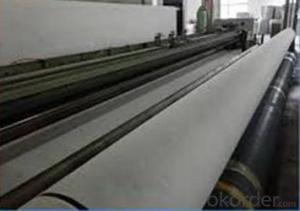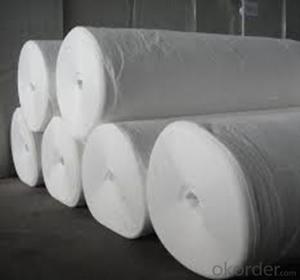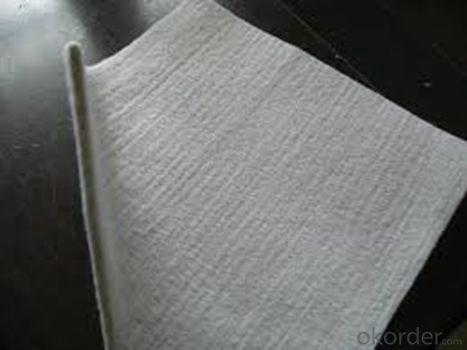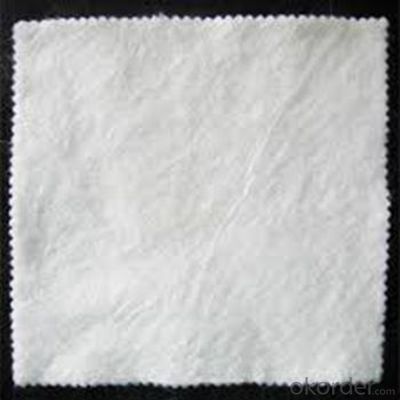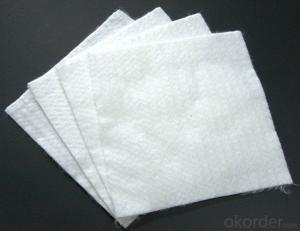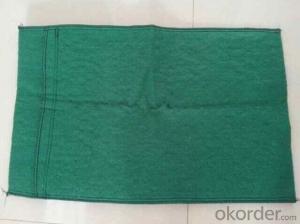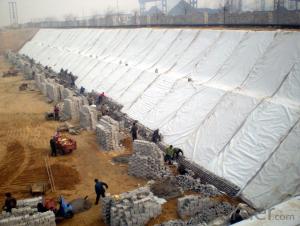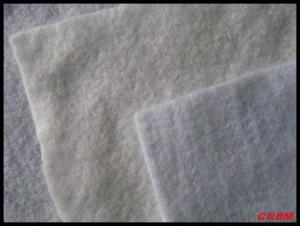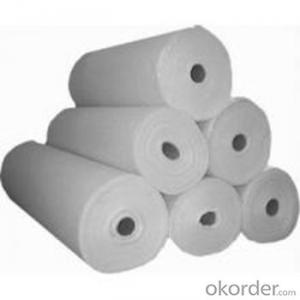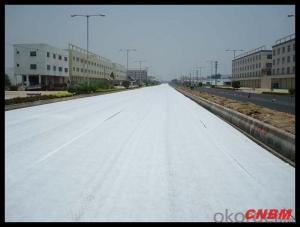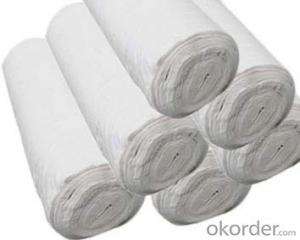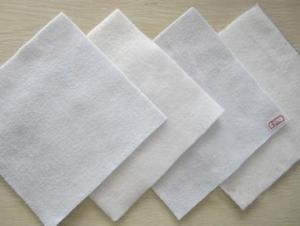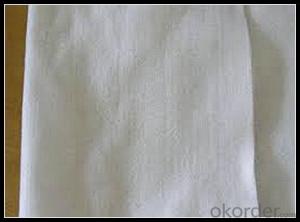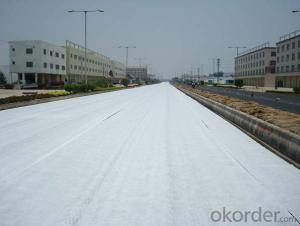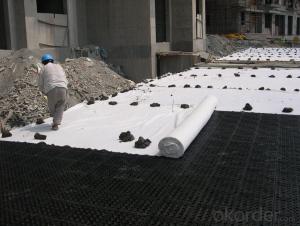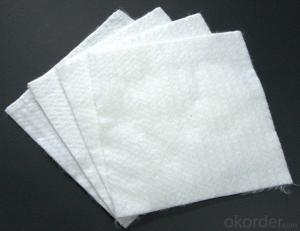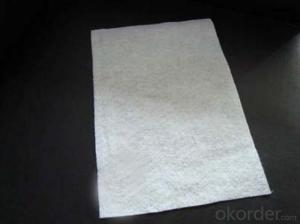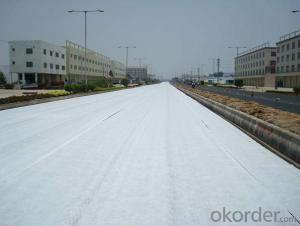High Strength Permeable Geotextile - Short Nonwoven with Polyester & Polypropylene for Construction
- Loading Port:
- China main port
- Payment Terms:
- TT OR LC
- Min Order Qty:
- 1000 m²
- Supply Capability:
- 100000 m²/month
OKorder Service Pledge
OKorder Financial Service
You Might Also Like
Specification
Product Introduction
Composite Geomembrane-Long filament geocomposite made of geotextile non woven and geomembrane
1.Characteristic: with high intensity and great elongation, large amount of modulus, acid-proof and alkali resistance, anticorrosive, with great tearing Strength and Brush Strength, fine spinning stickiness, good performance of anti-ageing and anti-freezing (won’t become embitterment even in 700Centigrade degree), with width of 5.0 meter.
2.Use: play the function of preventing seepage, separating, anti-cracking, consolidating, water draining in the horizontal plane in the projects, especially suitable for the seepage preventing projects with high watermark and water pressure.
3.Application: mainly be applied for the seepage-preventing projects in the railway bed, reservoir dam, rubbish landfill yard, tunnel and dyke.
4.Product Technical Data (Confirming GB/T17642-1998 standard)
PE membrane | 0.20 ~ 0.35 | 0.30 ~ 0.60 | ||||||
Mass per unit area | 400 | 500 | 600 | 700 | 800 | 900 | 1100 | |
Usual | One textile one film | 200/0.2 | 200/0.3 | 300/0.3 | 400/0.3 | 400/0.4 | 400/0.5 | 500/0.6 |
Two textile one film | 100/0.2/100 | 100/0.3/100 | 150/0.3/150 | 200/0.3/200 | 200/0.4/200 | 200/0.5/200 | 200/0.6/200 | |
Unit area tolerance % | -10 | |||||||
Tensile strength kN≥ | 10.0 | 10.0 | 15.0 | 20.5 | 20.5 | 20.5 | 25.0 | |
Elongation % | 40 ~ 80 | |||||||
Tear strength kN≥ | 0.28 | 0.28 | 0.42 | 0.56 | 0.56 | 0.56 | 0.70 | |
CBR plunger strength kN≥ | 1.8 | 1.8 | 2.6 | 3.5 | 3.5 | 3.5 | 4.7 | |
Vertical permeability cm/ s≤ | 10-12 | |||||||
Hydrostatic pressve Mpa≥ | 04 ~ 06 | 0.6 ~ 1.0 | ||||||
Explanation |
| |||||||
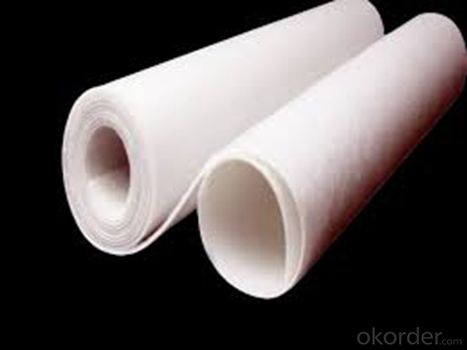
Packaging & Shipping
Packing: PLASTIC FILM INSIDE, AND WOVEN BAG OUTSIDE
Shipping: About 15 days after receipt the deposit
pecifications
geotextile fabric
permeability,filtration,easy for construction
ISO and CE certificate
Good quality and competitive price
Our Service
Quality assurance
1.On a regular basis or as per your request,we entrust national testing agencies to conduct quality inspections
2. Strictly in accordance with the ISO9001-2008 international quality system standard,we monitor and manage the whole process throughout production,quality testing,and measurement to ensure product quality
3. For quality-related construction delay or substandard construction(except for damage or losses due to customer’s responsibility or irresistible natural disasters),we have refunding,replacement,and repair services.We will respond to customers’ feedbacks on quality issues within 24 hours.
FAQ:
Q: What kind of payments does jenor support?
A: T/T, L/C, Cash are accepted.
Q: Do you charge for the samples?
A: Accordeing to our company policy, the samples are free, we only charge the freight fee. And we will return the freight fee during the next order.
Q: Can you produce according to customers' design?
A: Sure, we are professional manufacturer, OEM and ODM are both welcome.
Q: Do you have other products?
A: Yes, please check the pictures:
- Q: What are the regulations for geotextiles in construction projects?
- The regulations for geotextiles in construction projects vary depending on the country and specific project requirements. However, in general, geotextiles used in construction projects must meet certain standards and guidelines to ensure their quality and performance. These may include specifications for the physical properties, such as strength and durability, as well as requirements for permeability and filtration. Additionally, some regulatory bodies may have specific testing and certification processes that geotextiles must undergo before they can be used in construction projects. It is important for project managers and engineers to consult local building codes and regulations to ensure compliance with the specific requirements in their region.
- Q: What are the key factors affecting the durability of geotextiles?
- The key factors affecting the durability of geotextiles include the material composition, UV exposure, chemical resistance, physical properties, installation and maintenance practices, and environmental conditions such as temperature and moisture levels.
- Q: How do geotextiles help with drainage?
- Geotextiles help with drainage by allowing water to flow through them while preventing soil particles from clogging the system. They act as a filter, preventing the fine soil particles from entering the drainage system and causing blockages, thus improving the overall effectiveness and longevity of the drainage system.
- Q: What are the durability considerations for geotextiles?
- Durability considerations for geotextiles include factors such as tensile strength, resistance to ultraviolet (UV) degradation, chemical resistance, and abrasion resistance. Geotextiles should have sufficient tensile strength to withstand the stresses and strains imposed on them during installation and the lifespan of the project. UV degradation can weaken geotextiles over time, so it is important to choose products with appropriate UV resistance. Chemical resistance ensures that geotextiles remain intact and functional in the presence of chemicals or contaminants in the soil or water. Additionally, geotextiles should be resistant to abrasion to withstand any potential friction or rubbing against other materials or objects.
- Q: What are the different geotextile reinforcement techniques for slopes?
- Some common geotextile reinforcement techniques for slopes include slope stabilization, soil erosion control, and retaining wall construction. These techniques involve the use of geotextile materials, such as woven or non-woven fabrics, to reinforce and strengthen slopes, prevent soil erosion, and provide stability. Methods such as slope facing, slope wrapping, and soil nail reinforcement are employed to enhance the integrity and longevity of slopes in various construction and infrastructure projects.
- Q: What are the different geotextile performance properties?
- Some of the different geotextile performance properties include filtration, separation, drainage, erosion control, reinforcement, and cushioning.
- Q: What are the different geotextile permeability testing methods?
- Some different geotextile permeability testing methods include the constant head method, falling head method, and the flexible wall permeameter method. The constant head method involves applying a constant water head to the geotextile specimen and measuring the flow rate. The falling head method involves measuring the time it takes for the water level to fall a known distance in a permeameter connected to the geotextile specimen. The flexible wall permeameter method measures the flow rate through a specimen confined between two flexible walls. These testing methods help determine the permeability and hydraulic properties of geotextile materials.
- Q: Where to find the right geotextile
- Geotextile types are many, according to the manufacturing process of spinning, woven, woven, according to the material is divided into filaments, short wire and so on, if the most suitable geotextile should be the project requirements are not very strict , Generally like building coverage, road maintenance, etc., like this price is generally around 0.5 angle
- Q: What is the geotextile for ditch drainage?
- Is to use ordinary polyester staple geotextile, for the role of water filtration. Huazhi geotextile materials, geotextile solution manufacturers
Send your message to us
High Strength Permeable Geotextile - Short Nonwoven with Polyester & Polypropylene for Construction
- Loading Port:
- China main port
- Payment Terms:
- TT OR LC
- Min Order Qty:
- 1000 m²
- Supply Capability:
- 100000 m²/month
OKorder Service Pledge
OKorder Financial Service
Similar products
Hot products
Hot Searches
Related keywords
